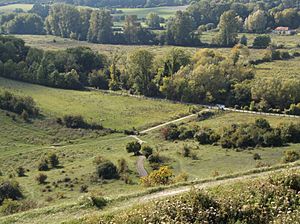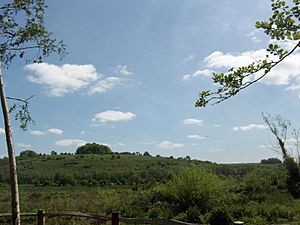St. Catherine's Hill, Hampshire facts for kids
| Site of Special Scientific Interest | |
 |
|
| Area of Search | Hampshire |
|---|---|
| Interest | Biological |
| Area | 43.0 hectares (106 acres) |
| Notification | 1986 |
| Location map | Magic Map |
St. Catherine's Hill is a special place for nature near Winchester in Hampshire, England. It covers about 43 hectares (which is like 106 football fields!). This area is protected as a Site of Special Scientific Interest because of its important plants and animals.
The hill is looked after by the Hampshire and Isle of Wight Wildlife Trust. Most of the hill is also an ancient Iron Age hillfort, which is a very old fort built a long, long time ago. This fort is protected as a Scheduled monument, meaning it's a really important historical site.
History of St. Catherine's Hill
The very top of St. Catherine's Hill has old walls and banks that were once part of an Iron Age hill fort. People built these forts to protect themselves over 2,000 years ago!
In the middle of the fort, there's a small group of beech trees. This is where a chapel used to stand in the 1100s. It was named after St. Catherine. You can also find a "mizmaze" here. A mizmaze is like a giant maze cut into the ground, probably made between 1647 and 1710. It's a fun puzzle to walk through!
For over 100 years, the hill was separated from the nearby Itchen water meadows. This happened when a railway was built in the 1890s and a main road (the A33) in the 1930s.
The railway closed in the 1960s. Later, in the 1990s, the old road was removed when the M3 motorway was built nearby. This helped connect the hill back to its historic surroundings on one side. However, it also meant the hill became more cut off from other hills to the east. Building the M3 motorway caused a big protest because many people disagreed with the new road going through Twyford Down.
St. Catherine's Hill was also a place where a unique game called Winchester College football was played. In 1922, some former students of Winchester College bought the hill. They then gave it to the college to help protect this special place.
Geology of the Hill
St. Catherine's Hill is part of a large natural fold in the chalk rock, called the Winchester anticline. Imagine pushing a rug from both ends; it would fold up in the middle. That's a bit like an anticline! This fold is at the western edge of the South Downs.
Over many years, the top part of this fold has worn away. This has revealed older rocks in nearby areas like Chilcomb and Winchester. It has also left a nearly complete ring of chalk hills that face inwards. These hills include Magdalen Hill, Telegraph Hill, Twyford Down, and St. Catherine's Hill itself.
St. Catherine's Hill is made of slightly older chalk than some of the taller hills nearby. Both types of chalk formed during the Upper Cretaceous period, which was a very long time ago when dinosaurs roamed the Earth! St. Catherine's Hill is separated from the higher Twyford Down by a dramatic dry valley called Plague Pits Valley. It is also bordered by the valley of the River Itchen to the west.
Images for kids




